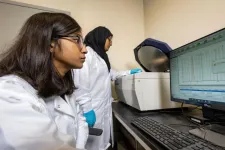(Press-News.org) Early detection is critical when it comes to curing diseases like cancer, but not everyone has easy access to screening tools. For problems in the genitourinary (GU) tract (which includes the kidneys, prostate, and bladder), health providers usually use a combination of screening tools, including blood tests, imaging, and physical examinations. Scientists are now working on an even simpler tool for screening illnesses before they become a problem – urine analysis.
According to a new study from scientists at The University of Texas at Arlington, Chan-Zuckerberg Biohub, and Stanford University, studying the RNA (a type of genetic material) and other substances within urine can show changes in cell types, revealing early signs of cancer and other diseases. This method could help clinicians detect problems earlier when they are more easily treated without invasive procedures.
“The current gold standard for detecting many GU ailments is a biopsy where small tissue is removed during a rectal exam and sent to the lab for analysis. The invasive nature of the test can scare some people from getting the care they need,” said Joseph Buonomo, assistant professor of chemistry at UTA and an author of the study. “Our preliminary research shows that studying the RNA found in urine can detect some ailments in their earliest stages where they are easily—and cost effectively—managed.”
In the study, the team collected urine samples from two groups of people – healthy individuals and people with kidney stones. Researchers took two types of RNA from the urine – cell-free RNA that floats freely in urine, and sediment RNA, which comes from solid particles. The types of RNA were then sequenced and analyzed, comparing the specimens from the healthy individuals to the ones with kidney stones. They found that advanced urine analyses identified patterns in cells indicative of whether a person has disease.
“We’re excited about this new research as it may lead to new, easier screening tools that can help detect diseases of the bladder, kidneys, and prostate,” said Buonomo. “Although our patient cohort was small, it lays the groundwork for development of a type of ‘non-invasive liquid biopsy’ that will be used to track the progression of ailments like kidney stones, diabetes, and cancer using urine instead of surgical specimens.”
The next phase of the research, Buonomo said, is working on advanced machine learning techniques to further fine-tune the types of differences that can be detected when comparing the RNA and protein signatures of healthy individuals to individuals with diagnosed diseases. They hope identifying additional biomarkers will pave the way for simpler, less invasive diagnostic procedures in the future.
***
This work was supported by grants from Chan Zuckerberg Biohub, Department of Veterans Affairs, Howard Hughes Medical Institute, National Cancer Institute, National Institutes of Health, National Science Foundation, and Stanford University.
About The University of Texas at Arlington (UTA)
Located in the heart of the Dallas-Fort Worth Metroplex, The University of Texas at Arlington is a comprehensive teaching, research, and public service institution dedicated to the advancement of knowledge through scholarship and creative work. With an enrollment of approximately 41,000 students, UT Arlington is the second-largest institution in the UT System. UTA’s combination of outstanding academics and innovative research contributes to its designation as a Carnegie R-1 “Very High Research Activity” institution, a significant milestone of excellence. The University is designated as a Hispanic Serving-Institution and an Asian American Native American Pacific Islander-Serving Institution by the U.S. Department of Education and has earned the Seal of Excelencia for its commitment to accelerating Latino student success. The University ranks as the No. 1 national public university in the U.S. for veterans (Military Times, 2024), No. 4 in Texas for advancing social mobility (U.S. News & World Report, 2025), and No. 6 in the United States for its undergraduate ethnic diversity (U.S. News & World Report, 2025). UT Arlington’s approximately 270,000 alumni occupy leadership positions at many of the 21 Fortune 500 companies headquartered in North Texas and contribute to the University’s $28.8 billion annual economic impact on Texas.
About The University of Texas at Arlington (UTA)
Located in the heart of the Dallas-Fort Worth Metroplex, The University of Texas at Arlington is a comprehensive teaching, research, and public service institution dedicated to the advancement of knowledge through scholarship and creative work. With an enrollment of approximately 41,000 students, UT Arlington is the second-largest institution in the UT System. UTA’s combination of outstanding academics and innovative research contributes to its designation as a Carnegie R-1 “Very High Research Activity” institution, a significant milestone of excellence. The University is designated as a Hispanic Serving-Institution and an Asian American Native American Pacific Islander-Serving Institution by the U.S. Department of Education and has earned the Seal of Excelencia for its commitment to accelerating Latino student success. The University ranks as the No. 1 national public university in the U.S. for veterans (Military Times, 2024), No. 4 in Texas for advancing social mobility (U.S. News & World Report, 2025), and No. 6 in the United States for its undergraduate ethnic diversity (U.S. News & World Report, 2025). UT Arlington’s approximately 270,000 alumni occupy leadership positions at many of the 21 Fortune 500 companies headquartered in North Texas and contribute to the University’s $28.8 billion annual economic impact on Texas.
About The University of Texas at Arlington (UTA)
Located in the heart of the Dallas-Fort Worth Metroplex, The University of Texas at Arlington is a comprehensive teaching, research, and public service institution dedicated to the advancement of knowledge through scholarship and creative work. With an enrollment of approximately 41,000 students, UT Arlington is the second-largest institution in the UT System. UTA’s combination of outstanding academics and innovative research contributes to its designation as a Carnegie R-1 “Very High Research Activity” institution, a significant milestone of excellence. The University is designated as a Hispanic Serving-Institution and an Asian American Native American Pacific Islander-Serving Institution by the U.S. Department of Education and has earned the Seal of Excelencia for its commitment to accelerating Latino student success. The University ranks as the No. 1 national public university in the U.S. for veterans (Military Times, 2024), No. 4 in Texas for advancing social mobility (U.S. News & World Report, 2025), and No. 6 in the United States for its undergraduate ethnic diversity (U.S. News & World Report, 2025). UT Arlington’s approximately 270,000 alumni occupy leadership positions at many of the 21 Fortune 500 companies headquartered in North Texas and contribute to the University’s $28.8 billion annual economic impact on Texas.
About The University of Texas at Arlington (UTA)
Located in the heart of the Dallas-Fort Worth Metroplex, The University of Texas at Arlington is a comprehensive teaching, research, and public service institution dedicated to the advancement of knowledge through scholarship and creative work. With an enrollment of approximately 41,000 students, UT Arlington is the second-largest institution in the UT System. UTA’s combination of outstanding academics and innovative research contributes to its designation as a Carnegie R-1 “Very High Research Activity” institution, a significant milestone of excellence. The University is designated as a Hispanic Serving-Institution and an Asian American Native American Pacific Islander-Serving Institution by the U.S. Department of Education and has earned the Seal of Excelencia for its commitment to accelerating Latino student success. The University ranks as the No. 1 national public university in the U.S. for veterans (Military Times, 2024), No. 4 in Texas for advancing social mobility (U.S. News & World Report, 2025), and No. 6 in the United States for its undergraduate ethnic diversity (U.S. News & World Report, 2025). UT Arlington’s approximately 270,000 alumni occupy leadership positions at many of the 21 Fortune 500 companies headquartered in North Texas and contribute to the University’s $28.8 billion annual economic impact on Texas.
About The University of Texas at Arlington (UTA)
Located in the heart of the Dallas-Fort Worth Metroplex, The University of Texas at Arlington is a comprehensive teaching, research, and public service institution dedicated to the advancement of knowledge through scholarship and creative work. With an enrollment of approximately 41,000 students, UT Arlington is the second-largest institution in the UT System. UTA’s combination of outstanding academics and innovative research contributes to its designation as a Carnegie R-1 “Very High Research Activity” institution, a significant milestone of excellence. The University is designated as a Hispanic Serving-Institution and an Asian American Native American Pacific Islander-Serving Institution by the U.S. Department of Education and has earned the Seal of Excelencia for its commitment to accelerating Latino student success. The University ranks as the No. 1 national public university in the U.S. for veterans (Military Times, 2024), No. 4 in Texas for advancing social mobility (U.S. News & World Report, 2025), and No. 6 in the United States for its undergraduate ethnic diversity (U.S. News & World Report, 2025). UT Arlington’s approximately 270,000 alumni occupy leadership positions at many of the 21 Fortune 500 companies headquartered in North Texas and contribute to the University’s $28.8 billion annual economic impact on Texas.
About The University of Texas at Arlington (UTA)
Located in the heart of the Dallas-Fort Worth Metroplex, The University of Texas at Arlington is a comprehensive teaching, research, and public service institution dedicated to the advancement of knowledge through scholarship and creative work. With an enrollment of approximately 41,000 students, UT Arlington is the second-largest institution in the UT System. UTA’s combination of outstanding academics and innovative research contributes to its designation as a Carnegie R-1 “Very High Research Activity” institution, a significant milestone of excellence. The University is designated as a Hispanic Serving-Institution and an Asian American Native American Pacific Islander-Serving Institution by the U.S. Department of Education and has earned the Seal of Excelencia for its commitment to accelerating Latino student success. The University ranks as the No. 1 national public university in the U.S. for veterans (Military Times, 2024), No. 4 in Texas for advancing social mobility (U.S. News & World Report, 2025), and No. 6 in the United States for its undergraduate ethnic diversity (U.S. News & World Report, 2025). UT Arlington’s approximately 270,000 alumni occupy leadership positions at many of the 21 Fortune 500 companies headquartered in North Texas and contribute to the University’s $28.8 billion annual economic impact on Texas.
About The University of Texas at Arlington (UTA)
Located in the heart of the Dallas-Fort Worth Metroplex, The University of Texas at Arlington is a comprehensive teaching, research, and public service institution dedicated to the advancement of knowledge through scholarship and creative work. With an enrollment of approximately 41,000 students, UT Arlington is the second-largest institution in the UT System. UTA’s combination of outstanding academics and innovative research contributes to its designation as a Carnegie R-1 “Very High Research Activity” institution, a significant milestone of excellence. The University is designated as a Hispanic Serving-Institution and an Asian American Native American Pacific Islander-Serving Institution by the U.S. Department of Education and has earned the Seal of Excelencia for its commitment to accelerating Latino student success. The University ranks as the No. 1 national public university in the U.S. for veterans (Military Times, 2024), No. 4 in Texas for advancing social mobility (U.S. News & World Report, 2025), and No. 6 in the United States for its undergraduate ethnic diversity (U.S. News & World Report, 2025). UT Arlington’s approximately 270,000 alumni occupy leadership positions at many of the 21 Fortune 500 companies headquartered in North Texas and contribute to the University’s $28.8 billion annual economic impact on Texas.
About The University of Texas at Arlington (UTA)
Located in the heart of the Dallas-Fort Worth Metroplex, The University of Texas at Arlington is a comprehensive teaching, research, and public service institution dedicated to the advancement of knowledge through scholarship and creative work. With an enrollment of approximately 41,000 students, UT Arlington is the second-largest institution in the UT System. UTA’s combination of outstanding academics and innovative research contributes to its designation as a Carnegie R-1 “Very High Research Activity” institution, a significant milestone of excellence. The University is designated as a Hispanic Serving-Institution and an Asian American Native American Pacific Islander-Serving Institution by the U.S. Department of Education and has earned the Seal of Excelencia for its commitment to accelerating Latino student success. The University ranks as the No. 1 national public university in the U.S. for veterans (Military Times, 2024), No. 4 in Texas for advancing social mobility (U.S. News & World Report, 2025), and No. 6 in the United States for its undergraduate ethnic diversity (U.S. News & World Report, 2025). UT Arlington’s approximately 270,000 alumni occupy leadership positions at many of the 21 Fortune 500 companies headquartered in North Texas and contribute to the University’s $28.8 billion annual economic impact on Texas.
END
New research shows urine tests may detect early diseases
Analyzing RNA in urine for cell changes may allow some individuals to avoid invasive biopsies
2024-10-23
ELSE PRESS RELEASES FROM THIS DATE:
Antibiotics and antifungals may slightly affect Parkinson's risk, study finds
2024-10-23
A Rutgers Health study has found that people who took multiple courses of penicillin antibiotics had a modestly lower risk of developing Parkinson's disease, a surprising finding that researchers say highlights the complex relationship between bacteria in the digestive tract and brain health.
The study, published in Parkinsonism & Related Disorders, analyzed medical records from more than 93,000 people in the United Kingdom. Researchers found that those who received five or more courses of penicillin antibiotics in the five years before diagnosis had about a 15% lower risk of Parkinson's compared with those ...
Nixing narcolepsy nightmares
2024-10-23
Nightmares affect 30-40% of patients with narcolepsy, but are often overlooked
Treatment can transform patients’ sleep and their daytime mood in a matter of weeks
Study found overall reduction in nightmare severity and frequency in six patients
CHICAGO --- A new Northwestern Medicine study has demonstrated a new way to treat narcolepsy-related nightmares.
The scientists combined cognitive behavioral therapy (CBT) and lucid dreaming to help patients in a small clinical trial.
“We had them imagine what they’d like to dream instead of their nightmare, almost like they’re writing a movie script,” said corresponding author ...
Mass General Brigham selected to receive $3.29 million award from ARPA-H’s Sprint for Women’s Health
2024-10-23
Mass General Brigham has been selected by the Advanced Research Projects Agency for Health (ARPA-H) as an awardee of the Sprint for Women’s Health to address critical unmet challenges in women’s health, champion transformative innovations, and tackle health conditions that uniquely or disproportionately affect women. Mass General Brigham will receive $3.29 million in funding over two years through the Sprint for Women’s Health spark track for early-stage research efforts.
Understanding and improving sleep is especially important for women, who face a higher risk of neurodegenerative diseases ...
The decision to eat may come down to these three neurons
2024-10-23
Speaking, singing, coughing, laughing, yelling, yawning, chewing—we use our jaws for many purposes. Each action requires a complex coordination of muscles whose activity is managed by neurons in the brain.
But it turns out that the neural circuit behind the jaw movement most essential to survival—eating—is surprisingly simple, as researchers from Rockefeller University recently described in a new paper in Nature. Christin Kosse and other scientists from the Laboratory of Molecular Genetics, headed by Jeffrey M. Friedman, have identified a three-neuron circuit that connects a hunger-signaling hormone to the jaw movements of chewing. ...
Woods Hole Oceanographic Institution researchers use the sounds of healthy coral reefs to encourage growth of a new species of coral larvae
2024-10-23
Woods Hole, Mass. – Coral reefs worldwide are in trouble. These ecosystems support a billion people and more than a quarter of marine species. Still, many have been damaged by unsustainable fishing and tourism, coastal construction, nutrient runoff, and climate change. Now, researchers have shown that broadcasting the sounds of healthy reefs is a way to encourage larval corals to repopulate degraded sites and help revitalize them.
A recent study done by researchers at the Woods Hole Oceanographic Institution (WHOI) showed that golfball coral larvae can be encouraged to settle when they hear the sounds of a vibrant, healthy reef. This is the second coral species ...
Researchers at NYU Tandon School of Engineering and KAIST develop method to 'hear' defects in promising nanomaterial
2024-10-23
An international research team led by NYU Tandon School of Engineering and KAIST (Korea Advanced Institute of Science and Technology) has pioneered a new technique to identify and characterize atomic-scale defects in hexagonal boron nitride (hBN), a two-dimensional (2D) material often dubbed "white graphene" for its remarkable properties.
This advance could accelerate the development of next-generation electronics and quantum technologies.
The team reported that it was able to detect the presence of individual carbon atoms replacing boron atoms in hBN crystals. This discovery was made possible by listening to ...
Biodiversity increases nutrient availability
2024-10-23
Animals not only need sufficient calories to function, but also essential nutrients — including omega-3 and omega-6 polyunsaturated fatty acids (PUFA). Insects and arachnids are an important source of these essential fatty acids for birds, hedgehogs, lizards and the like. However, the content depends on the specific types of insects and spiders consumed. Aquatic insects, such as caddisflies or dragonflies, contain significantly more omega-3 long-chain (LC) PUFA than terrestrial insects because omega-3- LC-PUFA rich algae form the base of the food chain in aquatic ecosystems.
The ...
American Society of Anesthesiologists names Donald E. Arnold, M.D., FACHE, FASA, new president
2024-10-23
PHILADELPHIA — Donald E. Arnold, M.D., FACHE, FASA, chair of the Department of Anesthesiology, Mercy Hospital in St. Louis and member of the board of directors of Western Anesthesiology Associates, Inc., in Ballwin, Missouri, was today named president of the American Society of Anesthesiologists (ASA), the nation’s largest organization of anesthesiologists. Dr. Arnold assumed office at the ANESTHESIOLOGY® 2024 annual meeting and will serve for one year.
“I’m honored to be named president of ASA and committed to serving our members, supporting the Society’s mission to advance the specialty, preserving physician-led anesthesia care, and above ...
Family as a wealth factor
2024-10-23
Wealth is one of the strongest indicators of social status, acting as a key indicator of social inequality and influencing access to education, health care and professional success. In a study, researchers from the Max Planck Institute for Demographic Research, the University of Cologne, GESIS and the Norwegian Institute of Public Health examined how financial wealth changes related to various generational transitions within families. The study used data from Norwegian registries and focused on people born in 1953.
Investigating changes in wealth within the ...
Breathing deep: A metabolic secret of ethane-consuming archaea unraveled
2024-10-23
Seeps on the deep seafloor naturally emit alkanes, which are pollutants that are potentially dangerous to life and act on global warming. Fortunately, the sediments around the seeps host microbes that act as a biological filter: They consume most of the alkanes before their release into the oceans and our atmosphere. This so-called anaerobic oxidation of alkanes is an important yet poorly understood microbial process. Scientists from the Max Planck Institute for Marine Microbiology in Bremen, Germany, now ...
LAST 30 PRESS RELEASES:
Ticking time bomb: Some farmers report as many as 70 tick encounters over a 6-month period
Turning garden and crop waste into plastics
Scientists discover ‘platypus galaxies’ in the early universe
Seeing thyroid cancer in a new light: when AI meets label-free imaging in the operating room
Neutrophil-to-lymphocyte ratio may aid risk stratification in depressive disorder
2026 Seismological Society of America Annual Meeting
AI-powered ECG analysis offers promising path for early detection of chronic obstructive pulmonary disease, says Mount Sinai researchers
GIMM uncovers flaws in lab-grown heart cells and paves the way for improved treatments
Cracking the evolutionary code of sleep
Medications could help the aging brain cope with surgery, memory impairment
Back pain linked to worse sleep years later in men over 65, according to study
CDC urges ‘shared decision-making’ on some childhood vaccines; many unclear about what that means
New research finds that an ‘equal treatment’ approach to economic opportunity advertising can backfire
Researchers create shape-shifting, self-navigating microparticles
Science army mobilizes to map US soil microbiome
Researchers develop new tools to turn grain crops into biosensors
Do supervised consumption sites bring increased crime? Study suggests that’s a myth
New mass spec innovation could transform research
Maternal nativity, race, and ethnicity and infant mortality in the US
Migration-related trauma among asylum seekers exposed to the migrant protection protocols
Jupiter’s moon Europa has a seafloor that may be quiet and lifeless
SwRI upgrades nuclear magnetic resonance laboratory for pharmaceutical R&D
House sparrows in northern Norway can help us save other endangered animals
Crohn's & Colitis Foundation survey reveals more than 1/3 of young adults with IBD face step therapy insurance barriers
Tethered UAV autonomous knotting on environmental structures for transport
Decentralized social media platforms unlock authentic consumer feedback
American Pediatric Society announces Vanderbilt University School of Medicine as host institution for APS Howland Visiting Professor Program
Scientists discover first method to safely back up quantum information
A role for orange pigments in birds and human redheads
Pathways to net-zero greenhouse gas emissions for Southeast Asia
[Press-News.org] New research shows urine tests may detect early diseasesAnalyzing RNA in urine for cell changes may allow some individuals to avoid invasive biopsies




